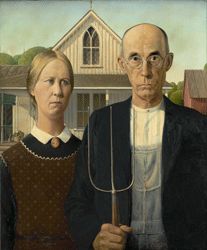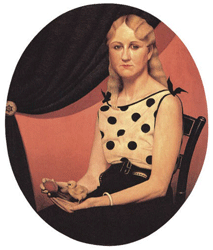|
American Gothic by Grant Wood is an iconic work of art akin to other iconic paintings, such as Campbell Soup by Andy Warhol and the Persistence of Memory by Salvador Dali depicting melted clocks. It was created for an art competition at the Art Institute of Chicago in 1930 when Wood was about 39 years old. He won third place and $300 for his future icon, and the Institute soon purchased the painting.
| 
|

|
|
American Gothic, 1930, oil on
beaver board, 30 3/4 x 25 3/4 in.
|
Grant Wood, ca. 1925.
(Photo: U.S. public domain.)
|
The two people Wood used as models in American Gothic were his sister Nan Wood Graham and his dentist Dr. Byron McKeeby. They actually represent a father and his daughter in the painting, not a husband and wife as so many believe.
Ted Carlton of Utah, Pat Kimbrell of the Old School Antique Mall in Sylva, N.C., Scott and Carolyn Brown of Memories Flea An’Tique Mall in Prattville, Ala., and Teresa P. Bland correctly identified them.
Grant Wood was born on an Iowa farm on Feb. 3, 1891. His family later moved to Cedar Rapids after the death of his father. Wood’s artistic ability eventually prodded him to make several trips to Europe to study the work of the great masters. It is said he applied the style of Flemish Renaissance art in the creation of American Gothic.1
| 
|
Portrait of Nan by Grant Wood was painted to make up for the criticism his sister received for her portrayal in American Gothic.
|
An Iowa farmhouse with a gothic window inspired Wood to create a painting that has been loved, disparaged, copied and adapted by art aficionados, art critics, artists and ad agencies around the world. Because of the daughter’s dour look in the painting and the severity of the father’s expression, many in the Midwest thought the painting was critical of them and their lifestyle. Others at that time saw this as a portrayal of strength in troubles times, particularly since the stock market had collapsed in 1929 and the country was in the Great Depression.
There is truth in both opinions. His models’ long faces and unhappy expressions were in harmony with the Gothic theme of the painting and could be interpreted as strength or mockery.
An interesting note: the pitchfork, which could be a symbol of honest labor or evil, is repeated on the bib of the father’s coveralls and upside down in the Gothic window of the house.2
Because his painting caused his sister to be heavily criticized, Wood painted a favorable, true-to-life portrait of her in a modern dress and holding a chick and a plum, representing her softer, feminine side.3 The work is called Portrait of Nan.
Neither did American Gothic represent dentist McKeeby’s true nature: “…although Wood painted McKeeby as a stern Iowa farmer, the dentist was known as a live wire in that part of Iowa, a man who loved to speed around town in a red sports car.” 4
Grant Wood passed away at the age of 51 on Feb. 12, 1942 from pancreatic cancer. While he was a leader in the Regionalism style of art, he was not well accepted by art critics or highly successful during his lifetime. However, today, his work is held by more than 25 museums, educational institutions and the Smithsonian. More of his work can be seen in the Cedar Rapids Museum of Art and online at www.crma.org. His Corn Cob Chandelier for Iowa Corn Room is not to be missed. (Corn cobs replace candles in the chandelier.)
--------------------------------------------------
1
Art Institute of Chicago, “Grant Wood,” www.artic.edu.
2 http://Smarthistory.KhanAcademy.org,"Grant Wood's American Gothic."
3 Smithsonian.com, “Meet Grant Wood’s Sister, the Woman Made Famous by ‘American Gothic,’” by Jamie Katz, May 2014.
4 Stephen G. Bloom, “Gothic Revival,” Chicago Tribune, Aug. 13, 1995
|